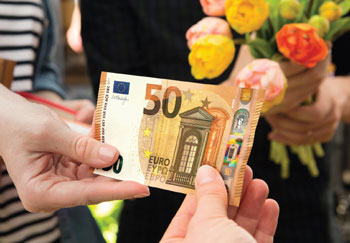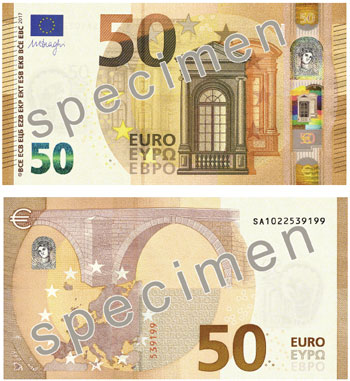Currency Notes
Seductive Bill
Finance & Development, September 2017, Vol. 54, No. 3
The recently redesigned €50 note is Europe’s most commonly used denomination

A small box of Belgian chocolate truffles with a bottle of champagne and some flowers. A dozen bottles of Belgian beer. Or 20 large servings of fries served in a paper cone. That’s what—along with a lot of friends—a €50 note can buy you in the European Union’s euro area. This bill inhabits European wallets and purses more frequently than all other denominations combined. The most widely used banknote in the euro area recently got a facelift to make it more attractive—and more secure.
We like our euro cash
For well over a decade, euro notes have been legal tender in an ever-growing number of European countries, rendering borderside currency exchange booths obsolete. Whatever the economic implications, most of the 338 million residents in the 19 euro area countries enjoy the convenience of a uniform currency. The latest available Eurobarometer survey shows that most people consider it a good thing both for their own country and for the European Union as a whole (57 percent and 69 percent, respectively).

And they use the euro in its physical form. There are 9 billion €50 notes in circulation (46 percent of all euro banknotes), and Europeans have a penchant for pulling them out at the checkout counter, mostly disregarding their plastic cards. “Even in this digital age, cash remains essential in our economy,” European Central Bank (ECB) President Mario Draghi said in April 2017, when the newly designed €50 note was released. “Three-quarters of all payments at points of sale in the euro area are made in cash,” he said.
So do counterfeiters
The original yellow-orange €50 note was popular with consumers and counterfeiters alike. It held the dubious honor of being one of the world’s most counterfeited, in the company of the US $20, Chinese ¥50, and India’s now withdrawn Rs 500 notes, according to the website Marketplace. That is one of the reasons the ECB embarked on the redesign, which includes other denominations, all with a common Europa theme.
The new €50 note, illustrated by Berlin-based postage stamp designer Reinhold Gerstetter, shows a generic Renaissance architectural motif to avoid favoring the building heritage of any single member country. It also boasts a host of security features, including a clear window with a hologram and a color-changing emerald number that central bankers expect will dissuade counterfeiting.
Experts may be fascinated by security features such as holograms and changing colors, but the average person pays little attention to such details, say neuroscientists.
“A great deal of effort goes into building security features on bills—but the problem has been that nobody then uses these. The ECB finally decided to take a different approach, one more rooted in psychology and neuroscience,” Stanford University neuroscientist David Eagleman, advisor on the Europa series design, told F&D. “I found that people have a difficult time noticing whether a building is imperfectly drawn—but they notice almost immediately if a familiar face is imperfectly drawn. As humans, evolution has given us extremely specialized hardware for face recognition. If you see a friend you can immediately tell if something has changed on his or her face. The same goes for the familiar face on a bill.”
That is why for the first time a human face has made it onto a euro bill. The tiny curly-haired lady is Europa, a Phoenician princess of complicated but high lineage, the continent’s namesake, who was seduced by Zeus, king of the ancient Greek gods.
The colorful, more secure new €50 note is the middle member of the Europa series, following the release of new €5, €10, and €20 bills. The final denominations—€100 and €200—are scheduled for release in early 2019. The largest denomination, €500, will not get a makeover: it will be allowed to disappear gradually from circulation because it has become a go-to denomination for criminals.


